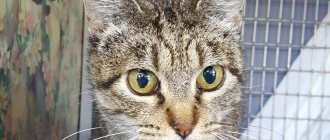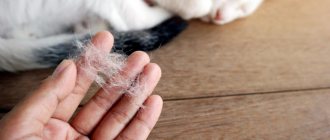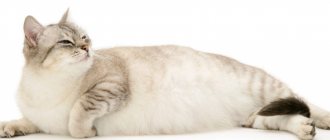Pregnancy in Maine Coons is longer than in other cat breeds. Therefore, kittens appear on average 7 - 10 days later than usual. How do the first signs of pregnancy appear and when should you expect babies? How to help the expectant mother and what complications may there be? What should a first aid kit consist of and what should be the place for childbirth? As well as advice on caring for a woman in labor.
First signs
The first signs of pregnancy appear approximately 3 weeks after the start of the last estrus. These include:
- Swelling of the cat's nipples (they become bright pink).
- Slight weight gain.
- No heat. The cat calms down and no longer asks for the cat.
- Changes in taste preferences (for example, the expectant mother begins to show interest in food to which she was previously indifferent, and vice versa).
There are no tests for feline pregnancy, but an interesting situation can be detected through ultrasound.
Length of pregnancy
It is impossible to say unequivocally how long a cat’s pregnancy will last. The average duration according to the calendar is 63-65 days, but the exact number of days cannot be determined for a number of reasons.
- Small cats weighing up to 2.5 kilograms can give birth earlier than usual - on days 56-60 of pregnancy. British cats over 5 kg can give birth even after the 65th day.
- In the case of the first pregnancy, a cat that carries less than 3 kittens most often gives birth at 60-65 days.
- A cat that is bearing kittens not for the first time can give birth earlier - on the 56-60th day.
- The length of pregnancy also depends on the number of babies in the womb: the more kittens, the higher the likelihood of premature birth
Progression by week
Veterinarians distinguish the following stages of pregnancy by week:
- 3 weeks after mating, the first signs appear.
- At 3–4 weeks, the cat develops toxicosis (due to hormonal changes). In this case, drowsiness occurs and appetite worsens.
- In the fifth week, the expectant mother noticeably gains weight. The cat's appetite improves and its belly becomes rounder. The pet becomes calmer and more affectionate.
- At 6 - 8 weeks, kittens begin to move (this can be noticed when observing the pet). Maine-kunsha becomes anxious and tries to find a secluded place to give birth.
- The ninth and part of the tenth week is the last period of gestation. The pet loses its appetite and begins to actively lick its belly and vulva.
During the period of contractions, the cat rushes about in search of a suitable place and meows loudly, attracting the owner’s attention and demanding help and care from him. This period lasts about a day, after which labor begins.
How to determine if a cat is pregnant
Every owner wants their cat to produce healthy and beautiful offspring. To do this, you need to take into account that childbirth is a very complex physiological process that requires a certain age and frequency:
- It is absolutely not worth breeding females under one year old. The age at which it is recommended to start mating is 18 months.
- The optimal maximum number of births per year is 2 times.
- The maximum age for breeding is 5 years.
Most individuals are already ready to conceive, starting at 6 months. But early childbirth is very harmful for a young body. It continues to develop until the age of two. However, some breeds are fully formed by the age of three, but can become pregnant earlier.
You should knit no earlier than a year
Now we will talk about uncontrolled reproduction , when the female walks wherever she wants . At the same time, her owner really does NOT want additional furry tenants to appear in the house.
It is very important to track the cat's first heat (this is a signal that she is ready to breed). There are no obvious signs of estrus. Therefore, you need to think about an unplanned pregnancy of a cat, even if she is still small. It is difficult to calculate the exact age of conception.
If you do not want your pet to give birth prematurely, then starting from five months, limit access to the street and cats to at least 8 months.
If you are not at all interested in procreation, then it is best to sterilize your pet. The recommended age for the procedure is eight months. The operation prevents not only unwanted pregnancy. Sterilized animals live longer because the body does not wear out as much and gets rid of gynecological diseases. In addition, the animal will not suffer due to unmet needs.
It's better to sterilize your cat if you don't want to breed kittens.
But in any case, you need to know and see the first signs of pregnancy. They appear in the second or third week after sexual intercourse. The first symptoms are the absence of estrus and morning sickness. Also, the expectant mother's nipples turn pink and swell, and the hair around them falls out. These signs do not always appear, so an ultrasound examination will help to more accurately confirm the position. The procedure is carried out in the third week after mating.
A few more characteristic signs:
- Lethargy.
- Change in appetite.
- Changing tastes.
- Affection is shown.
- Gaining weight.
- A pregnant cat's belly appears at 5–6 weeks.
Cat in a conspicuous position
- In later stages, breathing becomes heavier.
When are we expecting babies and how many will there be?
A pregnant cat lasts an average of 9 - 10 weeks (or 70 - 72 days).
Moreover, the duration of gestation greatly depends on the number of kittens in the litter.
The more there are, the sooner they will be born (in order to reduce the load on the body, the cat gives birth faster).
Babies born before the 62nd day have poor health and therefore require special care (otherwise they risk not surviving). In Maine Coons, the number of kittens in a litter is approximately 4 - 6, but there are cases where cats of this breed carried 10 kittens.
It is not recommended to feel the belly of a expectant mother in order to determine the number of fetuses in the womb, since it is possible to damage the vital organs of the cat - the mother or the offspring she is carrying.
Pregnancy in a cat: how long does it last?
If the mating process between a cat and a cat was successful, the cat becomes pregnant. This article will indicate the primary symptoms of pregnancy in a pet, how long this process lasts, and how many kittens can be born. We’ll also touch on topics related to looking after a pregnant cat, and talk a little about childbirth.
The pregnancy process in these animals lasts approximately nine weeks. It happens that labor may begin a few days later or earlier; this is normal practice. There are enough cases when kittens were born a week earlier and were healthy and playful. Remembering the symptoms of pregnancy will help you determine if your furry pet is pregnant.
The main sign is if the cat has not gone into heat. Initially, only this fact may indicate pregnancy.
Change in appetite. This is the second important symptom that indicates pregnancy. After a couple of weeks, the cat will begin to eat significantly more often, perhaps twice as much as usual.
If the owner knows the behavioral characteristics of his pet well, he may notice dramatic changes. The pet may lose interest in games and spend most of its time just lying on the couch.
As time passes, pregnancy can be determined by looking closely at the belly, which will become much larger. The animal's nipples will also increase in size.
Babysitting a pregnant cat
In fact, when a cat is pregnant, she does not require much specific care. The main thing is that the furry pet has enough food, and he is not overly physically overloaded (does not run, does not jump from the closet to the chest of drawers). In principle, this is quite enough. It is worth noting that if your cat eats cheap food, then during this period you can feed it more expensive food, which will contain the required amount of vitamins and useful elements.
Help for the expectant mother
The appropriate age for the first pregnancy is 8 - 10 months.
It is during this period (not earlier) that the pet is physically and hormonally ready to become a mother.
The correct course of pregnancy and appropriate care will help not only to avoid complications in the process of bearing kittens and subsequent births, but also to maintain the health of the cat.
It is advisable to start taking care of the animal even before mating with a cat. Therefore, it is important for the owner to know the basics of proper pet care (food, rest, help during toxicosis).
Pregnancy in cats
Personally, at this stage, fate has rewarded me with two male furry paws, so the happiness of cat motherhood does not threaten me. But this is not a reason not to understand the intricacies of the feline process of pregnancy and reproduction.
Usually, owners of domestic cats sterilize to avoid possible pregnancies, not to bother with the distribution of kittens, and to save the cat from suffering and diseases associated with the feline reproductive system.
But if you are sure that your “valuable fur” has unique characteristics of nature and breed and you really want striped, furry grandchildren, then it is better to approach the issue of cat pregnancy with all responsibility.
Toxicosis
The cause of toxicosis in cats is hormonal changes in the body, and in some cases, poor diet. Characteristic symptoms:
- Vomiting in the morning (has a light color and does not contain traces of blood or bile).
- Drowsiness and weakness.
- Increased nervousness.
- Decreased appetite.
- Unhealthy coat.
If you notice signs of toxicosis in a cat, you should not panic, because this is a normal physiological reaction to changes in hormonal levels. Toxicosis, as a rule, can be observed at 2 - 4 weeks of pregnancy, and it lasts on average about 10 days. Usually this condition does not require treatment and goes away on its own. But in case of prolonged toxicosis or significant deterioration of the condition, it is recommended to show the animal to a veterinarian.
False pregnancy in a cat
Usually, after mating, the cat becomes pregnant. The behavior of the pet and some signs confirm the interesting position of the animal: swelling of the mammary glands, caution of the female in behavior, enlargement of the abdomen. But after 3 or 4 weeks all symptoms disappear. This is called a false pregnancy , which is actually a hormonal imbalance in the cat's body. This negatively affects the animal's psyche.
The reasons for the occurrence of false pregnancy lie not only in hormonal imbalance: perhaps the mating was with a sterile cat, or the female’s body has pathologies of the reproductive system, disorders of the thyroid gland.
As treatment, a diet is prescribed and a reduction in the amount of dairy products in the pet’s menu, which will have a positive effect on the cat. It is important to show attention to the injured cat and surround it with care. It is advisable to add vitamins to food.
Nutrition and vitamins
Proper nutrition during pregnancy plays an important role in the formation of future babies. Therefore, veterinarians advise feeding your cat a balanced diet (there are special product lines designed for pregnant women). In addition to the daily diet, you can give your furry pet vitamins (Doctor Zoo, Seva, Canina, etc.).
You should not combine fortified feed and vitamins, as this can lead to the development of vitamin deficiency.
Selecting a location
The place for cat birth must be prepared in advance.
A large cardboard box is perfect for this purpose (approximate parameters: length and width at least 90 cm, height - 50 cm).
At the same time, one wall of the box needs to be trimmed a little so that it is convenient for the nursing mother to jump into the house (including so that she does not crush the kittens).
It is recommended to place soft bedding at the bottom of the box. During pregnancy, the cat needs to be introduced to the place for future birth. It is advisable to place the box in a quiet place where no one will disturb the mother and kittens.
When do you need veterinary help?
How to determine that labor has been prolonged, has taken a pathological form, and the animal needs help?
It is necessary to call a doctor at home or take a giving birth animal to him if:
- More than 24 hours have passed since the start of labor, and not all kittens were born during this time.
- The attempts are strong and frequent, and the kitten does not leave the birth canal for more than half an hour.
- The second stage of labor lasts more than 12 hours.
- There is profuse bleeding, green, brown, yellow discharge with an unpleasant odor.
- Not all placentas were born.
- The cat is unconscious.
Under no circumstances should you follow the advice of those who do not have a veterinary or at least zootechnical education, or are not a professional cat breeder.
Sometimes ignorant people give advice that is monstrous in its stupidity, and the owners, losing their heads with excitement for their pet, follow them:
- You cannot inject the hormone oxytocin to stimulate labor. Severe contractions after the injection often lead to uterine rupture and the death of the cat from bleeding.
- No-shpa should not be administered to relax the cervix. It often leads to paresis of the hind limbs, that is, to a violation of their motor function - paralysis. The nature of this pathology is neurological and difficult to eliminate. The animal may remain permanently disabled or will have to be treated by a veterinarian for a long time.
- You should not give your cat vodka either as an anesthetic or as anything else. Alcohol is a strong toxin, poison for animals!
- Do not put pressure on the stomach, pull the kitten by the head or paws, or expand the cat’s vagina with your fingers or tools. All these manipulations can lead to rupture of the birth canal, uterine prolapse, death of the litter and mother due to bleeding and damage to internal organs.
READ How to Train a Cat [9 Commands Video Lessons]
Only a veterinarian can provide real help to the mother and litter. Therefore, instead of experimenting on animals, you need to seek qualified help.
In most cases, the cat copes with the birth of kittens on her own. But there are times when the help of a loving owner is extremely necessary. Sometimes, due to fatigue and pain, a cat can “squeeze” a cub that is only halfway out. Most often, this happens if the kitten walks forward with its hind legs.
Such situations require immediate intervention. The easiest way to help is to grab the cat by the scruff of the neck so that it stands upright on its hind legs.
By switching to a new stimulus, the woman in labor will relax the vaginal muscles and the kitten will be born. If this does not help, then more radical measures should be taken. You need to carefully take the kitten with a gauze cloth (a clean cloth or a gynecological glove) and pull it out with light, rocking movements. This should be done at those moments when the cat begins to struggle.
And one more thing: the kitten must be held by the body and under no circumstances pulled by the tail or paws. Sometimes in newborn kittens the umbilical cord does not burst due to pushing. In this case, it also makes sense to intervene. To do this, you need to tie the umbilical cord at a distance of about 40 mm from the baby’s tummy and cut it from the abdomen. After this, the navel should be cauterized with brilliant green or iodine solution.
Normal birth in British cats does not require specialist intervention. However, owners should observe how the cat behaves after giving birth. If certain symptoms occur, you should immediately call your nearest veterinary clinic.
• labor does not begin more than 70 days after conception;
• there are signs of fever and increased temperature in cats before giving birth;
• fever in cats after birth;
• the appearance of bright red discharge from the vagina, lasting more than 10 minutes;
• unpleasant and pungent odor from the vagina;
• contractions in cats without continuation of labor for a long time (more than an hour);
• restless behavior of the cat after the termination of labor.
First aid kit for feline birth
You should stock up on tools for your cat's first aid kit in advance. So, during childbirth you cannot do without the following devices:
- Alcohol for disinfection.
- Scissors.
- Disposable diapers (they can be purchased at a veterinarian's store or pharmacy).
- Soft cloths or napkins (may be needed for rubbing newborn kittens).
If the owner has not previously taken part in a cat’s birth and is afraid, you can call a veterinarian to your home for a fee.
Why does the owner need to know the cat's due date?
Many owners, ignorant of issues of felinology - the science of keeping and breeding cats, are convinced that childbirth is a natural process in which it is better not to interfere, and the animal will instinctively figure it out on its own.
Childbirth is indeed a natural phenomenon, but baby pets are not always born easily and without problems.
The domestic cat is far from its ancient ancestor, the wild representatives of the cat family, in morphological and genetic characteristics. She leads a measured, well-fed and calm lifestyle, so her innate instincts are dulled.
Many cats, especially representatives of artificially bred breeds, need help when giving birth to kittens and when caring for them.
Therefore, pets need help in the process of giving birth to babies, and some even need help in mating, their instincts are so reduced.
Tips for caring for a new mother
The expectant mother requires special attention and special care. During this period, veterinarians recommend adhering to the following rules:
- Trim the hair around the pregnant woman's nipples (with scissors without sharp ends).
- A few weeks before giving birth, protect your pet from sudden movements.
- Spend more time with your cat (especially in the last days before the kittens are born).
- Do not take your pet on long trips.
- Provide your cat with healthy nutrition, peace and comfort.
- Give any medications only after consulting a veterinarian.
- After giving birth, keep the cat's house clean (change the bedding periodically).
- Monitor the color and consistency of your cat’s discharge during the postpartum period. Normally they have a reddish color, but after 4 - 6 days they acquire an increasingly lighter shade. If the cat is very weak, it is necessary to carefully remove discharge from the thighs and vulva using a damp towel.
- Provide the mother in labor with plenty of fluids.
- It is recommended to place bowls with food and water close to the cat's shelter.
- Do not let your pet go for walks during pregnancy and after giving birth (as she can pick up an infection from other cats and cats, and subsequently infect still immature kittens).
If a woman in labor appears weak, refuses to eat, body temperature rises to 38 - 39 degrees, or if the mammary glands become inflamed, consult a veterinarian immediately.
First pregnancy
A female British cat can become pregnant immediately after reaching sexual maturity - at the age of 6-18 months. However, you should not let your pet go to the cat too early, because pregnancy up to a year can not only harm the future offspring, but also the cat itself.
In the case of early pregnancy, birth may occur before the 50th day, especially if the cat became pregnant after her first heat. This is the worst situation, because the kittens in this case may be born dead or too weak.
The optimal age for pregnancy is from one to six years. Later, the cat’s sexual activity begins to decrease. Despite this, there are many cases where cats gave birth at 10-15 years of age, however, such a pregnancy, like premature birth, can have a bad effect on the cat and its offspring.
Possible complications
In the absence of proper nutrition, in case of hypothermia or overheating of the body, if the cat is infected with pathogenic microorganisms, the following complications are possible:
- Miscarriage (usually occurs at 4–5 weeks of pregnancy). In this case, lifeless fetuses may remain in the uterus, which will cause putrefaction and inflammation of the internal genital organs. In this case, you cannot do without the help of a veterinarian.
- Bleeding. It occurs as a result of rupture of the cervix during childbirth: scarlet fluid flows profusely from the vulva, and the cat lies on its side with its tongue hanging out. In the absence of timely treatment, the animal may die.
- Mastitis (inflammation of the mammary glands as a result of excess milk). In this case, redness and soreness of the nipples are observed, and yellowish breast discharge appears. In this case, the cat is isolated from the kittens and special treatment is carried out.
- Metritis (inflammation of the uterus due to infection). In this case, the animal becomes apathetic, the body temperature rises, and there is abundant discharge from the vulva with an unpleasant odor.
- Insufficient amount of milk (occurs, for example, with a large number of kittens, with a lack of adequate nutrition or fluid).
Duration
New owners are interested in the question: how long do Sphynx cats stay pregnant? Numerous observations and statistical data confidently put the figure at 60-62 days. Of course, the individual characteristics of the pet cannot be excluded.
Experts have noticed an interesting pattern: the older the cat, the more kittens it can bear. Let us also note the relationship between the number of kittens and gestational age. The larger the offspring, the faster the birth of the sphinx occurs. This is where the pregnancy calendar will help the owner, since large deviations are fraught with serious illness and loss of kittens.
Hairless sphinxes of various breeds (Canadian, Don, etc.) enter puberty before the body is fully formed. Therefore, pregnancy before a year is undesirable for cats. The optimal period varies around 13-15 months. To avoid health problems, sterilization of the Sphynx (Canadian, Don, etc.) should be carried out exclusively after the first birth.
We suggest you read: What is the best dry food for Labrador?
For clarity, let us note the stages of the sexual cycle of the sphinx:
- Condition preceding estrus. A kind of preparatory stage. Lasts 1-2 days.
- Estrus. Lasts up to a week.
- Condition after estrus. Lasts 3-4 weeks until the cat becomes pregnant.
Experts note some features of bearing kittens and pregnancy in general. Due to hormonal imbalance and lack of progesterone, estrus may become more frequent, which will lead to positive mating. What does this mean? At the time of birth, the Sphynx gives birth to kittens of various kinds.











